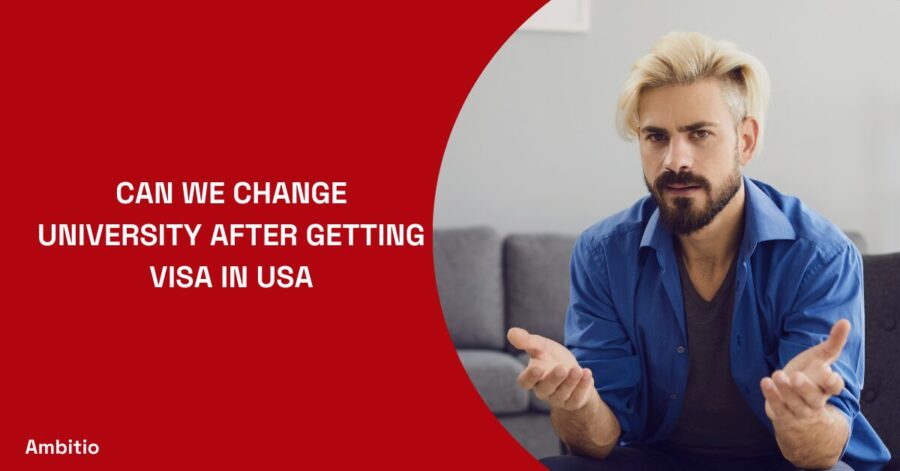13 December 2024
7 minutes read
Navigating the Process of Changing Universities After Booking Your US Student Visa Appointment

Introduction
Choosing the right university in the United States is a significant decision for any international student. However, circumstances can change, and you may find yourself needing to switch universities even after you’ve already booked your US student visa appointment.
This blog post delves into the complexities of this process, offering a step-by-step guide to navigating this change smoothly without jeopardizing your student visa status.
Understanding the Visa Process for Changing Universities After Booking Your US Student Visa Appointment
Embarking on your academic journey in the United States can be an exciting yet daunting experience. What adds to the complexity is when you decide to change your university after securing your student visa. Understanding the nuances of the F1 visa and related policies is crucial in navigating this process successfully.
The Initial Step: Receiving an I-20 Form from Your New University
Getting Accepted and Receiving a New I-20
The first step in changing your university is to get accepted by the new institution. Once accepted, the university will issue a new I-20 form, which is essential for your visa status. This form certifies your eligibility for an F-1 student visa and includes your SEVIS ID and the school code for the new university.
Understanding the I-20 Form
The I-20 form is more than just a document; it’s a key part of your student visa application. It contains important information about your program of study, the estimated cost of attendance, and your personal details. Ensure that all the information on the new I-20 matches your current visa application details.
Informing the US Embassy or Consulate of Your University Change
Communication is Key
If you’ve already scheduled or appeared for your visa interview, it’s crucial to inform the US embassy or consulate about your change in university plans. This step ensures that the embassy updates your visa application with the new university information.
Navigating the Embassy’s Procedures
Each US embassy or consulate may have different procedures for handling such changes. You may be required to provide additional documentation, such as the new I-20 form and a letter explaining your reason for changing universities. Prompt and clear communication with the embassy can help avoid any misunderstandings or delays in your visa process.
The SEVIS Transfer: Moving Your Student Record to the New University
What is SEVIS?
The Student and Exchange Visitor Information System (SEVIS) is a database used by the US government to track international students. When you change universities, your SEVIS record needs to be transferred from your old university to the new one.
The Transfer Process
To initiate the transfer, contact the international student office at your current university. They will need your acceptance letter from the new university and the new school’s SEVIS code. Once they have this information, they can transfer your SEVIS record electronically.
Timing is Crucial
The timing of your SEVIS transfer is crucial. It should ideally be done before your visa interview or, if your visa is already stamped, before you travel to the US. This ensures that your visa matches your SEVIS record, which is important for maintaining your student status.
Re-booking or Updating Your Visa Appointment
Assessing the Need for a New Appointment
In some cases, changing your university may require you to re-book your visa appointment. This is particularly true if your visa has not yet been stamped or if significant changes have occurred in your study plans.
How to Re-book Your Appointment
If you need to schedule a new appointment, you can do so through the US embassy or consulate’s online appointment system. Be prepared to explain your situation and provide documentation, such as your new I-20 form and acceptance letter from the new university.
Handling an Already Stamped Visa
If your visa is already stamped, consult with the embassy or consulate on the best course of action. They might require you to apply for a new visa or provide additional documentation to validate your change of university.
Preparing for the Visa Interview After Changing Universities
Importance of Being Well-Prepared
If you have to attend a new visa interview due to your university change, preparation is key. The visa officer will likely ask questions about your decision to change universities, so having a clear and honest explanation is important.
Documents to Bring to the Interview
Be sure to bring all relevant documents to your interview, including both your old and new I-20 forms, acceptance letters, and any correspondence regarding your university change. This will help demonstrate your genuine intention to study in the US and show that you have followed all necessary procedures.
Common Questions You Might Face
Prepare to answer questions about your reasons for changing universities, how it affects your study plans and your long-term goals. The visa officer’s main concern is to verify that your primary intention is to study in the United States.
Managing SEVIS Fees and Financial Considerations
When you decide to change universities after booking your US student visa appointment, managing your SEVIS fees and addressing financial considerations become crucial. These aspects are integral to ensuring a smooth transition and maintaining your legal status in the United States.
Understanding SEVIS Fees in Detail
The SEVIS (Student and Exchange Visitor Information System) fee is a non-refundable fee that all prospective F-1 students are required to pay. This fee funds the administration of the student tracking and monitoring program managed by Immigration and Customs Enforcement (ICE). When you pay this fee, it is associated with your specific SEVIS record, which contains your personal and academic information.
The Process of Transferring Your SEVIS Fee
Fortunately, if you have already paid the SEVIS fee for a particular visa application, it can be transferred to your new university. To do this, you need to inform the SEVIS administration about your university change.
This can be done online through the SEVIS website, where you will update your school information using the new university’s SEVIS code. It’s important to retain the receipt of your original SEVIS fee payment, as you might need to present it during your visa interview or upon entering the United States.
Timing of the SEVIS Fee Transfer
The timing of transferring your SEVIS fee is critical. It’s best to initiate the transfer as soon as you receive the new I-20 form from your new university. This ensures that when you attend your visa interview or enter the United States, your SEVIS record accurately reflects your current educational institution.
Impact on Your Visa Application
While the SEVIS fee transfer itself does not directly impact your visa status, an updated SEVIS record is necessary for the visa interview and entry into the U.S. If your SEVIS record does not match the details of your university, it could lead to complications or delays in your visa processing.
Financial Documentation for Your New University
Changing universities also means that you must provide updated financial documentation. The U.S. embassy or consulate will require proof that you have sufficient funds to cover your tuition and living expenses at the new university. This documentation can include bank statements, financial affidavits, scholarship awards, or sponsor letters.
Considerations for Scholarships and Financial Aid
If you were receiving scholarships or financial aid from your previous university, it’s essential to understand that these may not transfer to your new institution.
You’ll need to check with the financial aid office of your new university about available scholarships and apply accordingly. Similarly, if you have new scholarships or financial aid from the new university, ensure that this information is included in your financial documentation.
Maintaining Financial Stability
As an international student, maintaining financial stability is crucial. Budgeting and planning for expenses such as tuition, accommodation, food, insurance, and other living costs are imperative. It’s advisable to have a clear financial plan and possibly a contingency fund to address unexpected expenses or emergencies.
Communicating with Both Universities’ Financial Offices
Effective communication with the financial offices of both your current and new universities is vital. They can provide valuable guidance and assistance in ensuring that your financial records and documentation are in order for the visa process.
Regular Updates and Compliance
Keep your financial documentation updated and in compliance with the requirements of the U.S. embassy or consulate. Any changes in your financial situation should be documented and communicated to the relevant authorities to avoid any issues with your visa status.
After the Change: Maintaining Compliance with Your F1 Visa
Changing universities in the U.S. on an F1 visa involves more than just transferring academic credits. It’s crucial to understand and adhere to the guidelines that govern your F1 visa to maintain legal status in the United States. Non-compliance can lead to serious consequences, including the termination of your visa. Here’s what you need to focus on to stay compliant:
1. Update Your SEVIS Record Promptly:
Upon deciding to transfer to another university, your first step should be to update your SEVIS (Student and Exchange Visitor Information System) record. This involves notifying your current school’s international student office about your intent to transfer.
They will then release your SEVIS record to the new institution, where you’ll be issued a new I-20 form. This process should be completed within 15 days of starting at the new university.
2. Maintain Full-Time Enrollment:
F1 visa regulations require that you maintain full-time enrollment in an academic program. Full-time status typically means you must be enrolled in at least 12 credit hours per semester for undergraduate programs or a full course load as defined by your graduate program. Ensure you’re aware of what constitutes a full-time course load at your new university and adhere to these requirements.
3. Report Address Changes:
As an F1 visa holder, you are required to report any change of address to USCIS (United States Citizenship and Immigration Services) within 10 days of moving. This is usually done through your new university’s international student office, which will update your address in the SEVIS system.
4. On-Campus Employment Considerations:
If you plan to work on-campus at your new university, remember that F1 visa regulations allow you to work up to 20 hours per week while school is in session and full-time during breaks. However, you must receive authorization from your new university’s international student office before starting any employment.
5. Off-Campus Employment and Practical Training:
For any off-campus employment or internships, you must obtain explicit authorization through programs like Optional Practical Training (OPT) or Curricular Practical Training (CPT).
It’s important to note that changing universities might affect your eligibility for these programs, especially if you haven’t completed a full academic year at your first institution.
6. Regularly Check Your Visa Status:
Keep track of your F1 visa expiration date. Remember, your visa is different from your I-20, which might have a different end date. If your visa expires while you’re in the U.S., you can stay as long as your I-20 is valid and you are maintaining your status. However, if you travel abroad, you’ll need a valid visa to re-enter the U.S.
7. Keep Academic Performance Up:
Maintaining good academic standing is a requirement of your F1 visa. Falling below the required GPA or failing to make satisfactory progress in your program can lead to the loss of your F1 status.
8. Communication with International Students Office:
Regularly communicate with the international students’ office at your new university. They can provide guidance, help you navigate visa-related issues, and keep you updated on any changes in immigration policies.
Conclusion
Changing universities after booking your US student visa appointment can be a complex process, but with careful planning and adherence to the procedures, it can be a smooth transition.
Remember to communicate effectively with both your current and new universities, as well as the US embassy or consulate. Staying organized and proactive will ensure that your academic journey in the United States remains on track.
FAQs
Q1: Do I need to pay the SEVIS fee again if I change universities?
No, the SEVIS fee is transferable, but you must ensure that your SEVIS record is updated with your new university information.
Q2: Can I change universities after my F1 visa is stamped?
Yes, but you may need to undergo a new visa application process depending on the embassy’s regulations.
Q3: What should I do if I’ve already booked my visa interview?
Contact the US embassy or consulate immediately to inform them of the change and follow their guidance on the next steps.
Q4: Will changing universities after booking a visa appointment affect my student visa status?
As long as you complete all the necessary steps and maintain compliance with visa regulations, your student visa status should not be negatively affected.

You can study at top universities worldwide!
Get expert tips and tricks to get into top universities with a free expert session.
Book Your Free 30-Minute Session Now! Book a call now




























